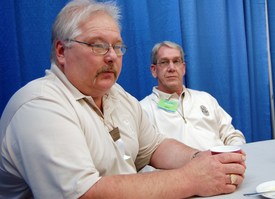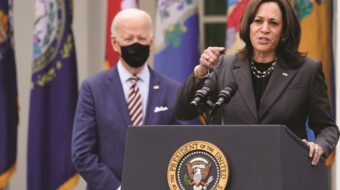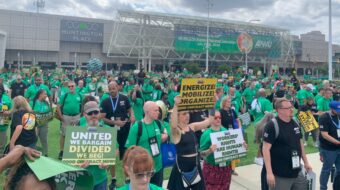
It was lunchtime at the 26th Convention of the AFL-CIO here yesterday and the painters, like everyone else were hungry. They had a makeshift “lunch room” off the convention floor near where labor journalists had their workspace and they invited two hungry Peoples World reporters to join them for a break and some food.
We filled our trays and sat at a table with four delegates: a 50-something Polish guy, an African American guy about the same age, a young African-American woman and a young Latino man.
A lot of people think of a closed, almost “whites only” all-male club when you say “painters’ union,” “brick layers,” or “iron workers.” We asked the group to share with us what it was their union, and apparently other building trades unions at the AFL-CIO convention, were doing to change this reputation.
“Twenty years ago, sadly, that is the way it was,” said Jeff Dobernecki, secretary-treasurer of the Painters’ District Council 88 in Georgetown, Texas. “I had real difficulty when I started out. Some of the good ole boys in the local down there didn’t think too much of Polish kids, much less Black kids. Then when I did get in the door we had to fight the bosses for the most basic things. There was no such thing as a vacation day in the buildings trades. ‘You’re doing work on construction and you want a paid day off? You’re crazy,'” they said.
“As the years went by the world changed. The people we fought were the ones who wouldn’t give us that day off. Our kids changed us too. When they invited their friends over, the house was full of Black kids, white kids, Latino kids and every other kind of kid. Young people help change the older generation.”
Larry Thomas, now in his 50s, grew up on Chicago’s South Side and started painting in 1974 when he was 18 years old.
“I painted where I could get a job, and at that time I never believed a young Black man would ever get a job in the building trades unions. I hung around the grounds wherever they were building and looked for work.
“Finally, in 1980, I got in after being recruited by a local CETA program that reached out to African Americans. The programs like that were quickly killed when Reagan got in. Other friends of mine got in as union steelworkers – when there was still an industry on the South Side.
“We only got those kinds of programs because we pushed for them. We fought, we marched and we fought and we marched. We were in Local 1332 on 77th and Cottage Grove. After a long hard struggle the union realized that everyone would be stronger if the workers fought the bosses rather than each other.
“I also think George Bush is a reason we see change. George Bush disgusted a lot of white people, people who didn’t want to change in the days of the civil rights marches. Young white people too, think differently these days.”
Breaking into the conversation, Dobernecki said, “It’s the young people who got a lot of their parents to vote for Obama, and with all this talk about politics I’m certain that next time around Obama is going to win with a bigger landslide than ever.”
Stephanie McLellan, the young African American woman who was also at the table, is an apprentice glazer from Philadelphia. She considers herself a beneficiary of the struggles for inclusion Thomas was so deeply involved in more than 20 years ago. “I didn’t have to fight my way in the door,” she said. “The union advertised a Diversity Apprenticeship program in my neighborhood so I filled out an application, took the test, passed and got into the program.”
“I was unemployed. My husband is a laborer and we have three kids, Willie who’s 5, Henry who’s 3 and Desiree who’s only one year old. We want to buy a house. It’s our dream. I knew I would have to get a good union job. Somehow, I always believed it would happen. I’m so happy and proud to be here. I’m also proud of my union. The union took steps that brought me here. Back home there are six other women, white, Latino and African-American, who came in the same way I did and now the union has started a program to reach out to high school kids in Philly.”
McLellan said the program includes work during the day and school at night. “It’s hard work and you have to stick with it. We even get 16 hours of political education in the school. You don’t finish the apprenticeship unless you know what the issues are. This is so important for empowering people. How are you going to fight for health care or for the Employee Free Choice Act unless you know the issues? Young people come out of our apprenticeship program knowing what they’re talking about.”
The other person at the table was Jose Lopez who, at the age of 38, is field coordinator of the union’s Job Corps program in Chicago.
Jose started as a painter in Chicago at the age of 19.
“From the beginning I was determined to be a good union member. I volunteered for work and I went for every job that was posted. Many of my white co-workers resented me being a painter. Their attitude was that Hispanics should have lesser jobs, but I worked hard and I toughed it out. When the union advertised its new training programs I applied. They took me in and now I work with the union training many more Hispanic youth, white youth and African American youth to get ready for the trade and for a variety of other trades. At my original job site and at sites all over Chicago the painters are coming from the neighborhoods where the work is being done. We are starting to look not only like a union but like a real community organization.”
As we left the Painters’ lunchroom at the convention center we understood even better why there is such a big push to bust unions in this country.












Comments